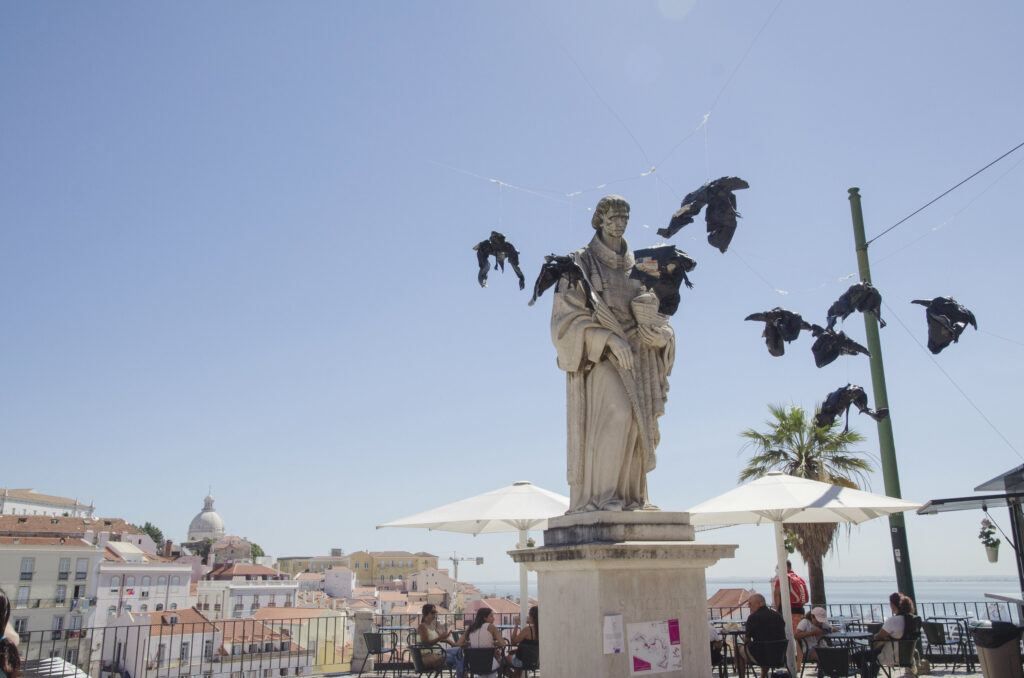I want to share with you some of the most special spots in Lisbon; the things that made our visit extra special this Summer. I feel compelled to do so because we had such a genuinely good time.
The Portuguese are such lovely and down to earth people.
Even Lisbon still had that hidden gem feeling, because they are not as overrun with tourists as some of their Mediterranean neighbours. Because it was a whole family trip we had to go in July, which I would usually avoid. The insane amount of sunshine hours Lisbon gets meant that the city was bathed in a pure light, which reflected off the pastel plaster, and the tiled buildings. The sardine paraphernalia around every corner is seriously endearing, and I went home with plenty of ceramics.
I could go on…

Our first two nights in Lisbon we stayed in Ibis Jose Malhoa, which was closer to the airport. Out of the window in our room I could see the very dominant arches of an aquaduct. After a peek in my trusty Lonely Planet Lisbon pocket book, we found that we could in fact, examine the 18th century structure up close. I’m a sucker for anything that is more than two centuries old, so I was game.
We wound down narrow streets, on a sweltering 34 degree afternoon, hoping that the trek during siesta would be worth it.

Mãe d’Água das Amoreiras
Was it ever…
We arrived in a small park underneath the aquaduct arches, where locals were walking their dogs, kids or reading a book. We quickly spotted the big canvas advertising for the Mãe d’Água (mother of water). We followed the path, and climbed the few steps of the entrance to the reservoir; I could feel the temperature drop (relief) before I even entered the double doors. We were met with subtle classical music, and the sound of running water echoing through the imposing cavern. I felt like I was at a spa, it was so relaxing and peaceful – there was no one else there. The beauty of this once key water source for the city, rendered us speechless.
Fado at Povo
The beautiful, longing sound of Portuguese Fado runs like a thread through our time in Lisbon. It can be heard floating from narrow houses in its birthplace, the streets of Alfama, as well as cafes and shops around the city. This form of soulful expression traces back to the early 19th century. Traditionally Fado tells tales of saudade; a longing and feeling of loss that does lifelong damage to a person’s soul. Vocalists are predominantly female, probably because the powerful wailing and dulcet tones very much suit a feminine vocal range.

On our final evening dad made reservations at Povo, a Fado bar close to our apartment. Povo has an artist residency program which gives young passionate Fado singers a stage to interpret Fado as a contemporary music form. At the end of the residency they record a song which goes onto Povo’s quarterly CD.
When the lights dim, there is total silence; “Fado is about to be sung!”
Our Fado songstress was Ines Homem de Melo. We had tapas whilst watching her perform. I truly fell in love with Fado that night; the emotion on Ines’ face, the respect for the singer displayed by the audience, and the knowledge that I was experiencing an authentic piece of Portuguese culture. Side note – the food was also quite good! Fado is sung in 15 minute intervals, so you can reorder in between.
Tuk Tuk Tour

One of the first things I noticed was the amount of tuk tuk’s that whizzed around the streets of Lisbon. I envied the tourists with windswept hair whilst we sweated through the hottest hours of the day. Whilst waiting in the sun for the tram with 25 others, a small red tuktuk pulled up with a fabulous young woman in it – she smiled at us and said “so, are you coming?”
It took some willpower not to jump in. On our final day, I persuaded my family that we couldn’t leave without doing it ourselves. Make sure you shop around, as every driver will charge you something different – it’s best to do some research online to get an idea of what you want to spend. We chose to tour for an hour and a half, and it was a very special way to see the city. Our guide was very knowledgeable, and because we took the tour on our final day, and not our first, he let us customize the route. One of the highlights was standing on top of Lisbon, with amazing 180 degree views over the city, fresh lemonade in hand, listening to him tell stories of the earthquake of 1755.

Santa Justa Lift & Evening Drinks
In the middle of the bustling shopping streets of Lisbon, this 45 metre iron lift can’t be missed. If it looks at all familiar it’s probably because it was designed by an apprentice of Gustave Eiffel; Raoul de Mesnier du Ponsard.
The looming, gothic structure looks slightly out of place, which makes it a prominent tourist attraction – much like it’s Parisian cousin. You can take the lift up to the Campo plaza for a couple of Euros – if you don’t mind standing in line for an hour. Tip; skip the queues, walk up, and pay to get to the top of the structure instead. The 360 views across the city are spectacular, and the photo ops equally so.
When you are all looked out, make sure to stop for a drink at the new bar that’s behind the Carmo convent, Carmo rooftop. It’s a great way to watch the golden evening light catch the rooftops over Baixa and Castelo de São Jorge – and they make a good cocktail!









Leave a Reply